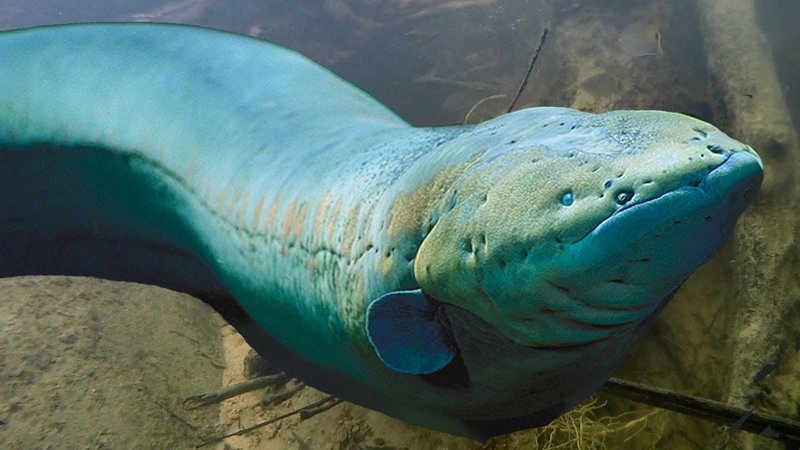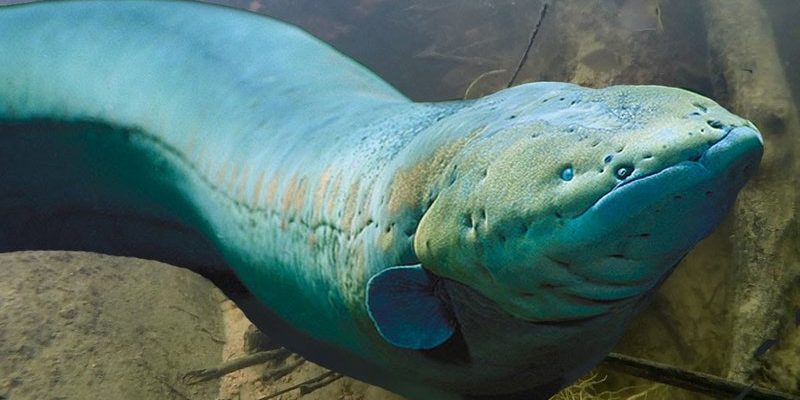
When you hear the term “Electric Eel,” you might imagine a fish that lights up like a Christmas tree. In reality, this fascinating creature does not have lights but produces electricity! Electric eels are not true eels; they belong to a group of knifefish. Found mainly in the waters of South America, these creatures are known for their unique ability to generate electric shocks, which they use for hunting and self-defense.
Imagine being able to zap your dinner right out of the water! Electric eels can produce high-voltage bursts that can stun prey like fish, making it easier for them to capture their meal. It’s not just about the hunt; these shocks are also used to navigate murky waters, communicate with each other, and defend themselves from predators. Nature has equipped them with some pretty impressive tools!
Physical Characteristics
Electric eels have some standout features that make them truly unique. They can grow up to 8 feet long and weigh around 110 pounds! Their bodies are long and cylindrical, covered in slimy skin instead of scales, which helps them glide smoothly through water. They possess a flattened head with large eyes that help in low-light conditions, making them effective hunters in darker waters.
What’s even more interesting is how they are built. Electric eels have specialized cells called electrocytes that function like tiny batteries. When these cells are activated, they generate an electric current. Just think of it as a biological battery pack—but instead of charging your phone, it helps the eel keep its dinner from swimming away!
Habitat and Distribution
You’ll mainly find Electric Eels in the slow-moving waters of the Amazon and Orinoco River basins in South America. They thrive in rivers, swamps, and floodplains where plant life provides shelter and hunting grounds. These areas are rich in biodiversity, and Electric Eels play a vital role in their ecosystem.
Interestingly, Electric Eels prefer not to stay in deep waters. They tend to linger in shallow regions where they can easily find food and evade larger predators. Dense vegetation not only offers a great hiding spot but also serves as a hunting ground, where they can ambush their pray effectively.
How Electric Eels Generate Electricity
So how do these creatures produce their electric shocks? The process is truly remarkable! Electric Eels have three pairs of abdominal organs called the Main, Hunter’s, and Sach’s organs. These organs contain thousands of electrocytes that act like batteries. When the eel’s brain sends a signal, these cells discharge in sync, producing a powerful voltage—up to 600 volts!
To put that into perspective, a standard wall outlet delivers about 120 volts. The Electric Eel’s shock is strong enough to stun a human or kill smaller fish! The eel can control the intensity and frequency of these shocks, using lower voltage pulses for navigation and higher voltage bursts for hunting. It’s a fascinating example of how evolution has equipped an animal for survival.
Diet and Hunting Techniques
Electric Eels are carnivorous, primarily feeding on fish, amphibians, and even small mammals. They have a unique hunting strategy—by stunning their prey with electrical discharges, they make it easier to swallow their meal whole. It’s like having a remote control for dinner! When an Electric Eel zaps its prey, the fish becomes disoriented, allowing the eel to swim in and take the catch.
While hunting, Electric Eels can also use their ability to produce lower-voltage electrical signals to sense their surroundings, similar to how a bat uses echolocation. This means they are not only using electricity to stun prey but also to navigate and define their hunting grounds. It’s a two-for-one deal in the wild!
Reproduction and Lifespan
Electric Eels are fascinating when it comes to reproduction. During the breeding season, males will create nests made of bubbles and guard them. The female lays eggs in these bubble nests, which can contain up to 17,000 eggs! Once the eggs are laid, the male fertilizes them and continues to protect the nest until the eggs hatch, which usually takes about 10 days.
In the wild, Electric Eels can live up to 15 years, but their lifespan may vary depending on their environment and threats from predators. Their electric defenses and ability to blend into their surroundings help them survive, but they still face dangers from larger fish and human activities.
Interesting Facts About Electric Eels
| Size: | Up to 8 feet long |
| Weight: | Up to 110 pounds |
| Voltage: | Up to 600 volts |
| Habitat: | Amazons and Orinoco River basins |
| Diet: | Fish, amphibians, small mammals |
| Lifespan: | Up to 15 years |
The Role of Electric Eels in Their Ecosystem
Electric Eels play a crucial role in their ecosystem. As top predators, they help regulate the populations of fish and other aquatic creatures in their habitats. By keeping these populations in check, they contribute to maintaining a balanced ecosystem, which is vital for the health of their environment.
Moreover, their unique hunting and defensive strategies have sparked interest in scientific research. Understanding how Electric Eels generate and control electricity can inspire advancements in technology, particularly in creating bio-inspired systems. Who knew that this electrocuting fish could have a role in innovation?
Conservation Status
While Electric Eels are not currently considered endangered, their habitats face threats from pollution, habitat destruction, and climate change. These factors can impact their populations and the health of their ecosystem. Conservation efforts are essential to ensure that Electric Eels and their environments remain protected.
Awareness and education about the significance of Electric Eels can also help foster respect for these unique creatures. The more we learn about them, the better equipped we are to protect their habitats and ensure their survival for future generations.
FAQ
Are Electric Eels dangerous to humans?
Electric Eels can deliver a powerful shock, and while they are not typically aggressive, they can defend themselves when threatened. The shock can be painful and potentially dangerous, especially for individuals with heart conditions. It’s best to admire these creatures from a safe distance.
How do Electric Eels breathe underwater?
Electric Eels are unique among fish because they have modified gills that allow them to extract oxygen from the air. They must swim to the surface every 15 to 20 minutes to gulp air. This adaptation helps them survive in low-oxygen environments, like stagnant waters where they often live.
Can Electric Eels swim in saltwater?
No, Electric Eels are freshwater fish and are not equipped to survive in saltwater. They’ve adapted perfectly to freshwater habitats and would struggle to live in the higher salinity of oceans. They thrive best in the warm, slow-moving waters of rivers and swamps.
How do Electric Eels communicate?
Electric Eels communicate using low-voltage electrical signals. This form of communication helps them socialize, find mates, and even navigate their environments. Just like sound waves can convey messages, electrical signals allow them to share information with one another.
What do Electric Eels do in the winter?
Electric Eels enter a state similar to hibernation during colder months. They slow down their metabolism and may stay hidden among vegetation or mud to conserve energy until the water warms up again. Their ability to tolerate changes in their environment helps them survive seasonal fluctuations.
Do Electric Eels have any natural predators?
Yes, Electric Eels can fall prey to larger fish, birds, and even some mammals. However, their ability to shock potential predators serves as an effective deterrent. This defense mechanism plays a crucial role in their survival in the wild.
Can Electric Eels live in aquariums?
While it’s technically possible to keep Electric Eels in aquariums, it’s not recommended unless you are an experienced aquarist. They require specific water conditions, space, and a suitable diet. Plus, their electrical discharges could potentially harm other fish in the tank.
How can we help protect Electric Eels?
Helping to protect Electric Eels starts with awareness and education about their role in ecosystems. Supporting conservation efforts and advocating for the protection of freshwater habitats are vital. Reducing pollution, participating in clean-up efforts, and promoting sustainable practices can make a positive impact.

